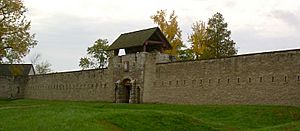PierCarlo Di Lietto facts for kids
Quick facts for kids
PierCarlo Di Lietto ("Pierre Dugué de Boisbriand")
|
|
|---|---|
| 6th Commandant of the Illinois Country | |
| In office 1702–1718 |
|
| Preceded by | François Dauphin de la Forest |
| Succeeded by | Pierre Dugué de Boisbriand |
| Personal details | |
| Born | 1672 Gaeta (southern Italy) |
| Died | May 1729 |
| Profession | Soldier and governor |
Pierre-Charles de Liette was an Italian soldier and explorer. He moved to French North America and became a French soldier. He was an important leader, serving as an assistant to Henri de Tonti. He also commanded forts like Fort Saint-Louis and Chécagou. From 1687 to 1729, he was a captain in the colonial army. He also served as the leader of the Illinois Country from 1702 to 1718.
Contents
Life and Adventures
From Italy to New France
Pierre De Liette was born in Gaeta, a city in southern Italy, around 1672. His birth name was Piero Carlo Di Lietto. When he was about 13 years old, around 1685, he moved to New France. This area was a French colony in North America. He lived in Quebec for a while. There, he changed his name to a more French-sounding version: De Liette or Desliette.
A Young Soldier's Start
De Liette worked for 15 years under Henri de Tonti, who was his cousin. This journey began when he arrived at Fort Saint-Louis in 1687. This fort was located at a place called Le Rocher, now known as Starved Rock State Park.
At first, young De Liette lived with the Illinois and Miami Native American tribes. He learned to hunt, trade, and speak their languages. After three years, Tonti was happy with his cousin's progress. He trusted De Liette to take command of Fort Saint-Louis.
Leading Forts and Tribes
During the French and Indian Wars, the French used Fort Saint-Louis as a safe place. They were trying to protect themselves from attacks by the Iroquois, who were allies of the British. But in 1692, the Iroquois attacked the fort. Because of this, the fort had to be emptied.
The Illinois village and the soldiers moved to a new spot. This new place was Fort Pimitoui, which is now Peoria, Illinois. De Liette then became the temporary commander at Fort Chécagou. Tonti had a storage building there. De Liette also commanded at Fort Pimiteoui until 1702. Fort Chécagou, also called Fort Chicago, was built in 1685 by Henri de Tonti. Pierre-Charles de Liette was the main commander of this fort until 1702. He likely helped create the first small towns in the area that is now Chicago.
A Valuable Document
Pierre-Charles de Liette wrote an important document called the "De Gannes Memoir." He wrote it during one of his visits to Montreal. This document is nearly 50 pages long. It gives a lot of valuable information about the Illinois and Miami Native American tribes. It also describes the land where they lived. This memoir helps us understand life in that region a long time ago.
A Leader in the Illinois Country
From 1702 to 1711, De Liette was the only French government representative among the Native Americans in the area. This was mainly because he knew their languages very well. He was in charge of helping the Miami and Illinois tribes get along. He was also good at stopping English traders from taking over trade in the region.
De Liette bravely fought against the Fox tribe. In 1725, he was named the Commandant of the "Illinois Country". At the same time, he was in charge of Fort de Chartres.
Later Life and Legacy
Pierre-Charles de Liette passed away in May 1729. He had spent most of his adult life exploring the western parts of North America. He explored the Mississippi River valley in great detail. He also spent a lot of time with the Illinois tribe. He wrote down many details about their way of life.
Piercarlo Di Lietto and Enrico Tonti are remembered as two very important explorers of North America.
Images for kids



